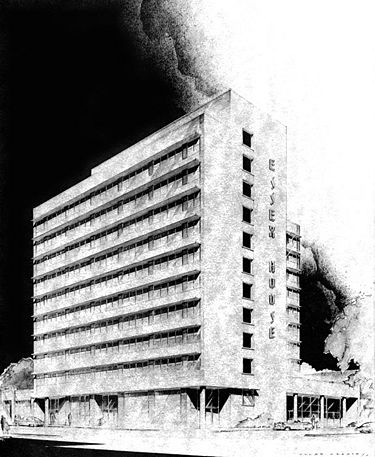Essex House: Difference between revisions
Patriarca12 (talk | contribs) mNo edit summary |
No edit summary |
||
| (12 intermediate revisions by 2 users not shown) | |||
| Line 1: | Line 1: | ||
The '''Essex House''' was a 10-story, 88,515-square-foot high-rise apartment building built on the northeast corner of [[6th Avenue North]] and [[Richard Arrington | [[Image:Essex House logo.png|right]] | ||
The '''Essex House''' was a 10-story, 88,515-square-foot high-rise apartment building built on the northeast corner of [[6th Avenue North]] and [[Richard Arrington Jr Boulevard North]] in downtown Birmingham. Constructed in [[1951]] and demolished in [[1997]], many consider it to have been the first modernist high-rise constructed within the city after [[World War II]]. | |||
The Essex House was developed by the [[Walter-Kanter Companies]] as a "new concept of gracious living". The building featured electronically-controlled high-speed elevators, aluminum-framed windows in every room, a 24-hour switchboard service, wall-to-wall carpeting, air-conditioning, and built-in cabinets with electric appliances. The design was created by the firm of [[Pembleton & Mims]] architects, with associate [[Henry Caldwell Jr]] heavily involved in the work. Ben Alboum was credited as "decorator and master craftsman" in early publicity. | |||
[[Image:Essex House rendering.jpg|left|thumb|375px|Rendering of the Essex House by Allan Greasby]] | |||
The building functioned as private apartments for 18 years while various commercial tenants occupied the ground floor spaces. In [[1966]] the [[Downtown Club]] constructed a meeting hall adjoining the Essex House. In [[1975]] [[Dale's Cellar]] moved to the building from 1927 [[7th Avenue North]]. The restaurant's famous [[Dale's Steak Seasoning]] was manufactured in the basement for retail sale. | |||
==BHA ownership and decline== | ==BHA ownership and decline== | ||
| Line 10: | Line 14: | ||
By early [[1994]] the cost of renovating the tower had increased from $2.6 million to $6.8 million. As a result, the BHA decided to sell the property altogether for $1.2 million in July [[1994]]. By January [[1997]], the property was purchased along with the neighboring [[Downtown Club]] by [[Energen]] to be demolished and make way for their new corporate headquarters. | By early [[1994]] the cost of renovating the tower had increased from $2.6 million to $6.8 million. As a result, the BHA decided to sell the property altogether for $1.2 million in July [[1994]]. By January [[1997]], the property was purchased along with the neighboring [[Downtown Club]] by [[Energen]] to be demolished and make way for their new corporate headquarters. | ||
At 8:20 a.m. on Saturday, March 1, [[1997]], the tower was imploded by Hudgins & Company, with mayor [[Richard Arrington]] pushing the button. The blast utilized 200 to 300 pounds of Power Ditch explosive to bring down the building. The only reported damage from the blast was four shattered windows at the [[Tutwiler Hotel]] across the street. It took six weeks for crews to remove the 10,000 tons of debris created from the implosion. | At 8:20 a.m. on Saturday, [[March 1]], [[1997]], the tower was imploded by Hudgins & Company, with mayor [[Richard Arrington]] pushing the button. The blast utilized 200 to 300 pounds of Power Ditch explosive to bring down the building. The only reported damage from the blast was four shattered windows at the [[Tutwiler Hotel (1986)|Tutwiler Hotel]] across the street. It took six weeks for crews to remove the 10,000 tons of debris created from the implosion. | ||
==References== | ==References== | ||
* | * Schnorrenberg, John M. (June 1992) "Harry Pembleton; Pembleton and Mims; Mims, Gaunt, and Poole; Mims and Gaunt: Perspective Renderings of Works from an Architectural Practice, 1938-1992." exhibition catalog. Birmingham Public Library | ||
* | * Nabbefeld, Joe (June 1, 1993) "Old Essex House will get new look, reopen in 1994." {{BN}} | ||
* Dedrick, Patricia (January 12, 1997) "Energen plans complex on Essex, Club site." | * Nabbefeld, Joe (July 11, 1994) "BHA plans to sell damaged 10-story apartment building." {{BN}} | ||
* | * Nabbefeld, Joe (April 12, 1995) "[http://bplonline.cdmhost.com/cdm/ref/collection/p4017coll2/id/1649 Arrington envisions building site as grassy courtyard]" {{BN}} | ||
* | * Dedrick, Patricia (January 12, 1997) "Energen plans complex on Essex, Club site." {{BN}} | ||
* Sanford, Peggy (March 2, 1997) "A mighty boom rocked Birmingham early Saturday morning as the 10-story Essex House crumbled to make way for a new building." {{BN}} | |||
* Bryant, Walter (March 2, 1997) "Essex lives on, memories remain of downtown landmark." {{BN}} | |||
==External links== | ==External links== | ||
* [http://www.emporis.com/en/wm/bu/?id=206776 Essex House] on Emporis.com | * [http://www.emporis.com/en/wm/bu/?id=206776 Essex House] on Emporis.com | ||
[[Category:Downtown apartments | [[Category:Downtown apartments]] | ||
[[Category:1951 buildings | [[Category:1951 buildings]] | ||
[[Category: | [[Category:Pembleton & Mims buildings]] | ||
[[Category: | [[Category:10-story buildings]] | ||
[[Category:6th Avenue North | [[Category:1997 demolitions]] | ||
[[Category:21st Street North | [[Category:6th Avenue North]] | ||
[[Category:21st Street North]] | |||
Latest revision as of 16:31, 21 April 2016
The Essex House was a 10-story, 88,515-square-foot high-rise apartment building built on the northeast corner of 6th Avenue North and Richard Arrington Jr Boulevard North in downtown Birmingham. Constructed in 1951 and demolished in 1997, many consider it to have been the first modernist high-rise constructed within the city after World War II.
The Essex House was developed by the Walter-Kanter Companies as a "new concept of gracious living". The building featured electronically-controlled high-speed elevators, aluminum-framed windows in every room, a 24-hour switchboard service, wall-to-wall carpeting, air-conditioning, and built-in cabinets with electric appliances. The design was created by the firm of Pembleton & Mims architects, with associate Henry Caldwell Jr heavily involved in the work. Ben Alboum was credited as "decorator and master craftsman" in early publicity.
The building functioned as private apartments for 18 years while various commercial tenants occupied the ground floor spaces. In 1966 the Downtown Club constructed a meeting hall adjoining the Essex House. In 1975 Dale's Cellar moved to the building from 1927 7th Avenue North. The restaurant's famous Dale's Steak Seasoning was manufactured in the basement for retail sale.
BHA ownership and decline
The Birmingham Housing Authority purchased the building in 1969. It was utilized by the BHA as 120 apartments for low-income seniors. In 1988, HABD was forced to abandon the tower as a result of roof damage and other decay to the structure. To address these issues, the authority spent $1 million in renovating the tower in 1991. However, these renovations fell short in bringing the tower up to code as both roof damage and a crack in the concrete top floor were not adequately repaired.
By 1993 the building was renamed the Daniel-Branscomb Tower in honor of former authority board members, Bennerea Daniel and Dr. Louise Branscomb. Later that year, the authority announced that major renovations would occur at the property including such improvements as a new roof, replacing the plumbing, installing water heaters and rewiring the outdated electrical system. Additionally, the property would be transformed from 120 efficiency units into 72 larger apartment units. Bradfield Richards Associates of Atlanta were commissioned for the project slated to commence in September 1993 and be complete by September 1994.
By early 1994 the cost of renovating the tower had increased from $2.6 million to $6.8 million. As a result, the BHA decided to sell the property altogether for $1.2 million in July 1994. By January 1997, the property was purchased along with the neighboring Downtown Club by Energen to be demolished and make way for their new corporate headquarters.
At 8:20 a.m. on Saturday, March 1, 1997, the tower was imploded by Hudgins & Company, with mayor Richard Arrington pushing the button. The blast utilized 200 to 300 pounds of Power Ditch explosive to bring down the building. The only reported damage from the blast was four shattered windows at the Tutwiler Hotel across the street. It took six weeks for crews to remove the 10,000 tons of debris created from the implosion.
References
- Schnorrenberg, John M. (June 1992) "Harry Pembleton; Pembleton and Mims; Mims, Gaunt, and Poole; Mims and Gaunt: Perspective Renderings of Works from an Architectural Practice, 1938-1992." exhibition catalog. Birmingham Public Library
- Nabbefeld, Joe (June 1, 1993) "Old Essex House will get new look, reopen in 1994." The Birmingham News
- Nabbefeld, Joe (July 11, 1994) "BHA plans to sell damaged 10-story apartment building." The Birmingham News
- Nabbefeld, Joe (April 12, 1995) "Arrington envisions building site as grassy courtyard" The Birmingham News
- Dedrick, Patricia (January 12, 1997) "Energen plans complex on Essex, Club site." The Birmingham News
- Sanford, Peggy (March 2, 1997) "A mighty boom rocked Birmingham early Saturday morning as the 10-story Essex House crumbled to make way for a new building." The Birmingham News
- Bryant, Walter (March 2, 1997) "Essex lives on, memories remain of downtown landmark." The Birmingham News
External links
- Essex House on Emporis.com

